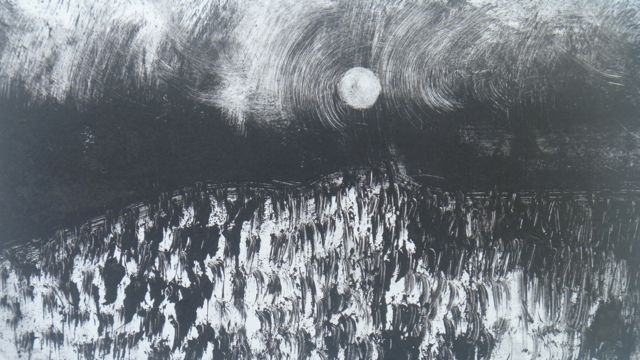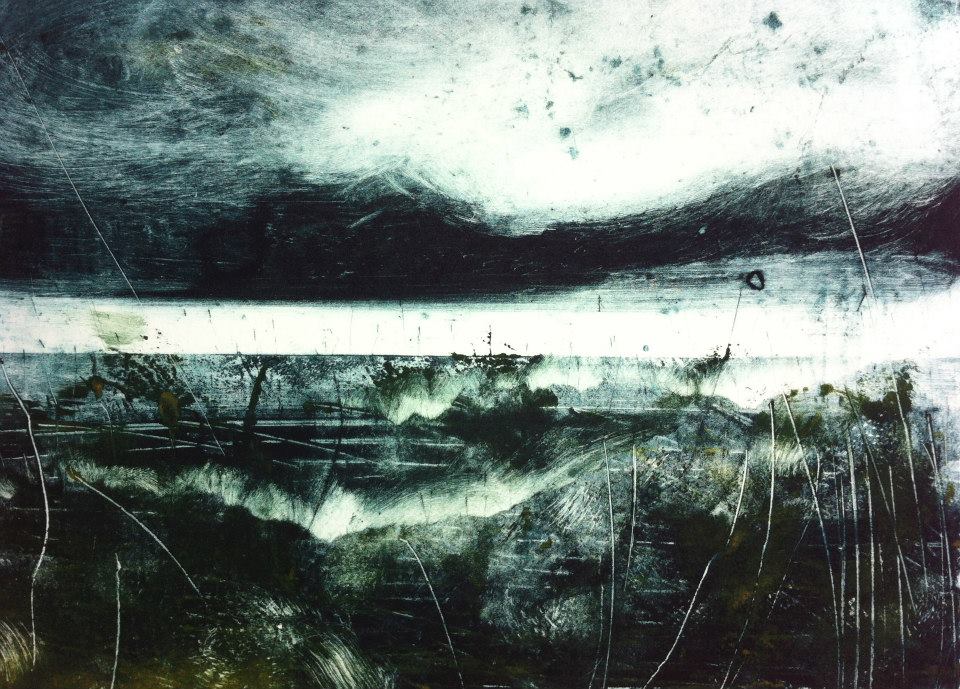“The poet Gillian Clarke says in her poem ‘October’:
“I must write like the wind” and that’s how I feel about my life, my art.
I am in a rush to express my marks, my thoughts, my feelings, my responses.
This artistic process is a journey and it’s not easy.”
Lesley Birch’s new exhibition, entitled ‘March into Spring,’ opened last week. Situated within Priestley’s at No. 36’s new White Room Gallery, the exhibition comprises of an array of recent work; a combination of mono-prints and paintings. Birch is a prolific and experienced artist, evident in the sophisticated and theatrical works displayed here. The exhibition mainly consists of flamboyant turquoise canvases and climactic black-and-white or navy-gold prints. The former works wind around half of the exhibition space; these large canvases are simultaneously jubilant and nostalgic in terms of their colouring and contents, while being unsettling with elements of the uncanny in their inclusion of lofty and insubstantial figures.
I was transfixed by Birch’s Edge of the World series. Predominantly small and intricate works, these handmade, original one-off prints appear as etchings from afar; highly atmospheric, Birch creates visions of sea mist and waves, a sense of billowing cloud and sea air, leaving traces of her artistic processes, including bristles and scratches. This series is inspired by the classic 1937 film of the same name, set on a secluded Scottish island. The film is an eerie illustration of the harsh aspects of nature and its powerful forces. Birch engages with this theme; these prints evoke a variety of natural conditions, implying at once magnificence and relentlessness. The introductory text of the film ‘The Edge of the World’ throws light upon Birch’s artistic intentions:
‘The slow shadow of death is falling on the outer isles of Scotland;
This is the story of one of them – of all of them.
When the Roman fleet first sailed round Britain,
They saw from the Orkneys a distant island,
Like a blue haze across a hundred miles of sea.
They called it Ultima Thule.’
Birch’s ‘O Worship the Moon’ (above) articulates the nature of the moon’s brightness in the night-time sky; its light suffuses the implied darkness through the artist’s scraping lines: the dry-point creates a rough and frenzied effect, emphasising the deep contrast between black and white, between darkness and light. There is a sense that what lays in the foreground may be a vast crowd of worshippers, working against themes of loneliness seen within the other prints, towards thoughts of pagan group worship within the natural world. Or a body of water or hillside, lit up by the pervading moonlight.
The black-and-white mono-prints are theatrical and full of wonder. ‘Pilgrimage’ (below) seems to echo the tone of ‘O Worship the Moon,’ moving closer to the ground on which a group of figures walk. From afar the implication of a crowd is highly successful; this exhibition allows us to look at the works closely, to examine the way in which these prints are created. In addition to this, a glass case within the exhibition features illuminating extracts of Lesley’s own words and information regarding print making. Looking at this work with care, one can imagine the thick black marks to be the cloaks of pacing individuals, advancing along the moonlit shore.
Birch states that she first became interested in printmaking when in Cambridge, fourteen years ago. Artist and friend, Claire Maria Wood, became Lesley’s mentor, and she was soon exposed to Curwen Print Studios, which deeply impacted and inspired her.
“I went into a sort of zone with printmaking, loving the unexpected element which happens along the way and later learning new processes from drypoint to collagraph and etching.”
Birch’s ‘From Arran’ (below) presents the viewer with an ominous and moody grey sky, juxtaposed with luminous blues and greens, indicating a misty, bright day. The deep blue ocean looms towards us, ahead of the sand dunes. This work is nostalgic for the artist, who states that it draws upon fond memories of staying with her aunt. The use of acrylic makes this work appear to shimmer in the bright lights of the white room, while the layers of paint give texture and a clustered sandy appearance to the canvas.
“The element of passing time is a major theme in my work. Viewers respond in their own way. It may be the colours or the sense of nostalgia.”
“All I’m doing is following my intuition. I’m not too concerned with purist printmaking. My aim, always, though, is to create a sense of atmosphere in the outcome. Each piece is unique, a one-off. I don’t work in editions. I do like to work in a series, using a theme as a basis for a body of work. Recent series have been inspired by Wordsworth, Michael Powell’s 1937 film ‘The Edge of the World,’ and Cities, Past and Present. I am really a painter/printmaker.”
‘Another Ship Passes’ (below) differs from the stark black-and-white prints and vibrant turquoise paintings; it is a relatively subdued work; its deep navy blues contrasting lightly with beige and hints of gold offering a sense of resplendent moonlight. A ghostly lone figure watches as a ship sails past the island; the figure is formed through a lack of delineation or colour, adding to its mysticism. The film ‘The Edge of the World’ was dedicated to all of the people on the lonely island of Foula, where it was created; there is a sense of isolation to this work, reflecting this sense of a sparse island. This work exemplifies the layering that occurs when Lesley creates a work: these layers cease to be tampered with only when the work is considered complete.
“The joy of painting on a printing plate is exciting and satisfying to me.
The inks move easily around the plate and I mix colours directly as I’m creating.
The inks can also be wiped off to create areas of white.
Over time, the plates become scuffed and dirty – all the better for me.
I re-use them, but each image will be individual – an original picture.”
“I’m wiping off paint more than applying it.
I am scratching into the work as well to create a textured look.
Paintings such as ‘Another Ship Passes’ express this process.
For me, it’s all about the marks I make. They are the identity of the artist.”
Another Birch work, entitled ‘Across the Lake’ (below), presents us with what appear to be two violent seascapes. The deep blue-green tones, darkening towards the base of the images, contrast with the white mist towards the top, while the artist increases the sense of drama and tension through scraping away at the material, creating a feeling of this being a fearsome and forceful storm.
This is furthered within ‘Night Sea’ (below), a breathtaking and decisive work that articulates the relation between hazy, sweeping clouds and vigorous, dynamic waves. Again, scratches at the surface enhance the impact of the threatening tide; these works seem to evoke instability and jeopardy, while exploring the fact that we are often at the will of nature, are subordinate and vulnerable to its worst moments.
“You get into a sort of excited trance when painting or printmaking
and it’s that butterfly feeling in the tummy
which I search for all the time – it’s very exciting.
Like jamming in a band, when it all just happens naturally.”
The contents of this exhibition meanders poetically between the ravages of winter storms and the light sea breezes of the summer months; displaying these works towards the end of Winter can be read as a statement, a gesture, marking the end of this season and our succession into Springtime.
“I’m now 55, the age at which my mother died, and I keep working at it;
my imagination keeps me young and I’m not giving up.”
Birch’s bodies of water encourage the viewer to contemplate elements of nostalgia, memory, fear and turbulence, while the implication of human presence builds on the edgy atmosphere, creating a sense of disquiet and unknowing. Leaving traces of the acts of creation enhances this; she is conscious of this and enjoys making works that express an immediate moment, deliberately leaving bristles and scratches. There is a sense that within her work she strives to mark her presence in this world.
Priestley’s at No. 36 recently opened the White Room Gallery, an intimate and bright space below the shop, inviting artists to exhibit their work in a fresh and cosy room. ‘March into Spring’ opened on 3rd March and runs until 29th March 2014. Further artist information, including details of upcoming exhibitions, can be found on Birch’s website, which features details of her Edge of the World series.
*
1. Lesley Birch, O Worship the Moon. Monoprint on Somerset Paper. Edge of the World series, 2013.
2. Lesley Birch, Pilgrimage. Monoprint. Edge of the World series, 2013.
3. Lesley Birch, From Arran. Acrylic on canvas, 2014.
4. Lesley Birch, Another Ship Passes. Oil on Paper. Edge of the World series, 2013.
5. Lesley Birch, Across the Lake. Monoprint with drypoint. Wordsworth series, 2014.
6. Lesley Birch, Night Sea. Monoprint with drypoint. Edge of the World series, 2013.
7. Lesley Birch in her studio, Thumbnail Sketches. 2013.
All images are sourced from Lesley’s website and Facebook page.
*
Katherine April Caddy, 10th March 2014.








Delighted to read this article on my work. Thank you Katherine. I really enjoyed your interview.
You’re so welcome, Lesley. I thoroughly enjoyed engaging with your artworks. Thank you for your time ~ your words really enhanced this article.